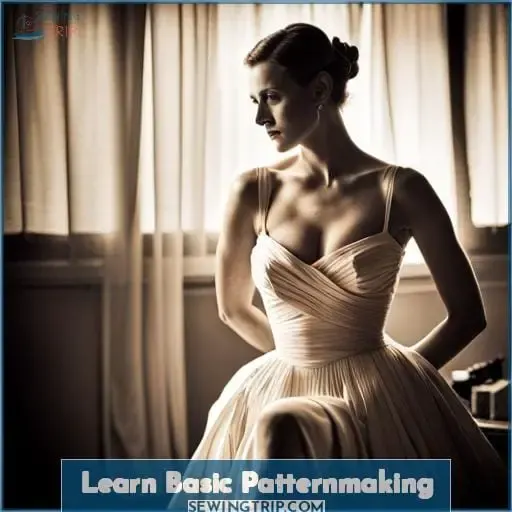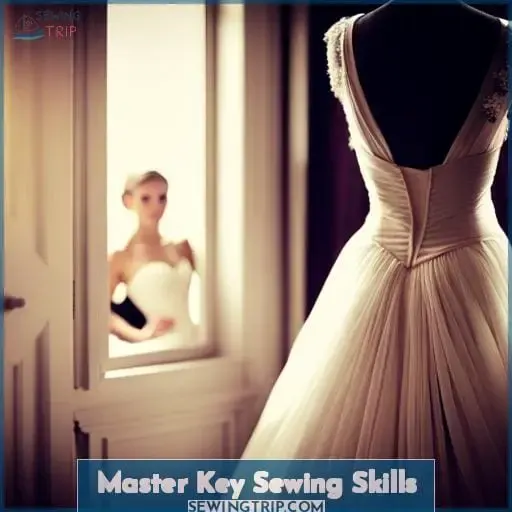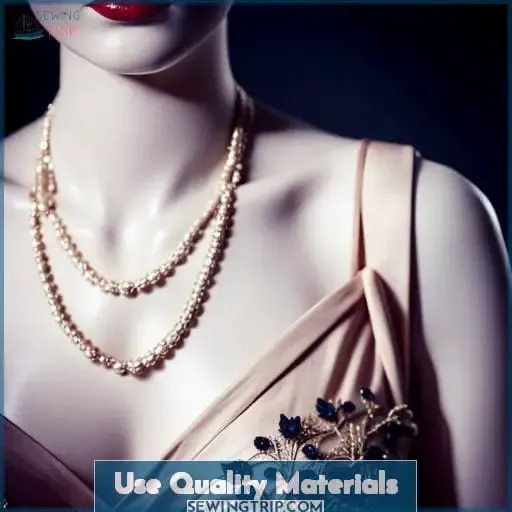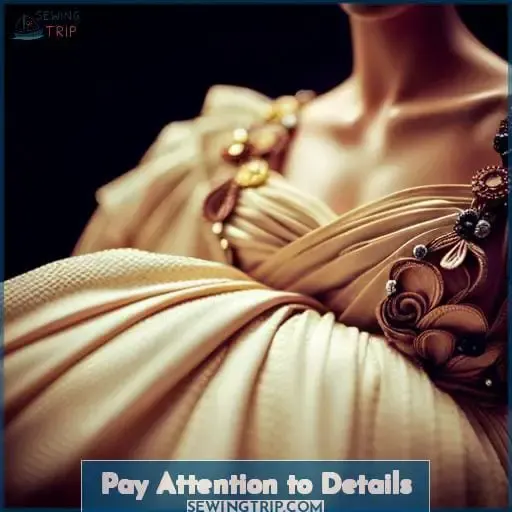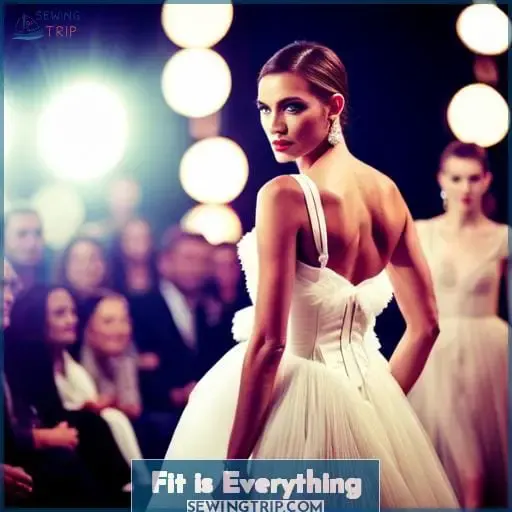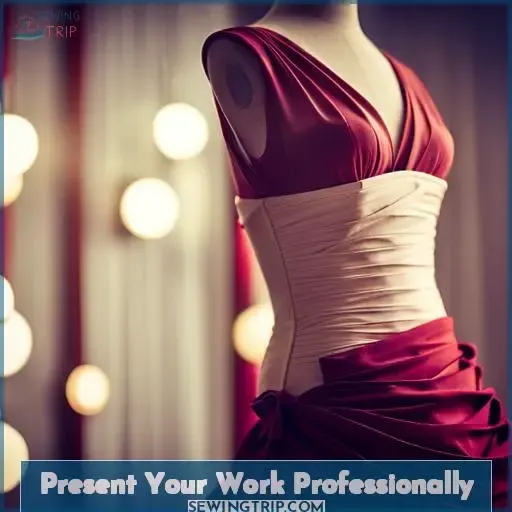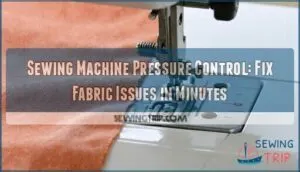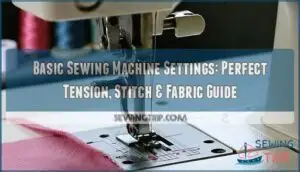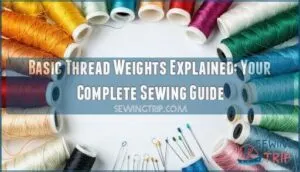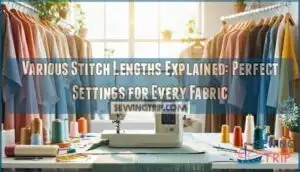This site is supported by our readers. We may earn a commission, at no cost to you, if you purchase through links.
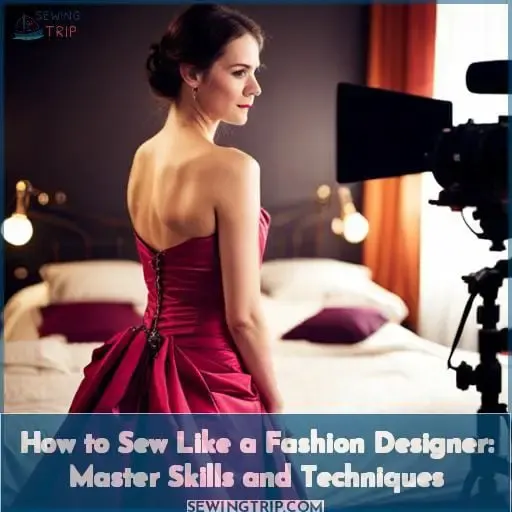 You’ve dreamed of freedom through fashion, yet found sewing intimidating.
You’ve dreamed of freedom through fashion, yet found sewing intimidating.
But liberation awaits through mastery of essential techniques.
From patternmaking and stitching to pressing and fitting, each skill unlocks self-expression.
With patience and practice, those who persevere craft uniqueness.
So refresh your curiosity, sharpen your focus.
The path to designer innovation begins with a single stitch.
Table Of Contents
Key Takeaways
- Pay close attention to fit – make muslins, check patterns, and anticipate adjustments.
- Master patternmaking fundamentals like darts, easing, and manipulating fullness.
- Use quality materials and employ precision techniques for cutting, marking, and stitching.
- Experiment with silhouette shaping through darts, pleats, gathering, and fullness.
Learn Basic Patternmaking
Start by learning the basics of patternmaking.
Draft your own patterns from measurements or adapt basic blocks to create original designs.
Understand ease – the difference between body and garment size – and how to build it into patterns.
Evaluate fit on a dress form, checking seam lines, grain, and measurements.
Make muslins to test patterns before cutting into fashion fabrics.
As you sew, focus on precision – carefully cut, mark, and stitch pieces together.
Master garment construction techniques like darts, zippers, and finishing to produce quality work.
With practice, you’ll gain the technical skills and eye for detail needed to design and sew garments from start to finish.
Let patternmaking unlock your creativity as a fashion designer.
Master Key Sewing Skills
- Focus on precision cutting, stitching, and pressing as you construct your garments.
- Pay close attention to these fundamentals to achieve a high-quality final product.
Cutting
When working on your master smocking, first pin your pattern pieces to the fabric and carefully cut them out with sharp scissors.
Use a self-healing mat for precision cutting.
Transfer all pattern markings, notches, and grainlines to the fabric.
Check pattern placement to maximize fabric usage.
Cut with care and patience for best results.
Stitching
You master stitching by first selecting the proper stitch type, length, and tension for your fabric and intended use.
Design Feature
Lightweight, delicate fabric
Sturdy fabric, construction seams
Decorative details
Thread tension is also crucial. Too much tension can pucker the fabric, while too little can cause skipped stitches.
Staying stitches are temporary stitches used to hold fabric in place before sewing.
Pivoting is a technique used to turn a corner without creating a sharp point. To pivot, stop sewing with the needle in the fabric. Lift the presser foot and turn the fabric. Lower the presser foot and start sewing again.
These are just a few of the basic stitching techniques that fashion designers should know. With practice, you’ll be able to master these techniques and create beautiful, professional-looking garments.
Pressing
After stitching each seam, you’ll need to press the garment well. Proper pressing is crucial for achieving professional results when sewing fashion garments.
Use the grain of the fabric when pressing to prevent distortion.
Press seams open for a smooth finish inside garments.
Always use a pressing cloth to avoid shiny marks on fabric.
Let garment sections cool fully before moving to prevent imprints.
Use Quality Materials
Using quality materials is key to sewing like a fashion designer.
You’re better off starting with quality fabrics, linings, interfacings, and notions, even if they cost a bit more. This prevents frustration and disappointment later when trying to create professional results after cutting corners on materials.
Carefully select fabrics with the appropriate weight, drape, and hand for your designs.
Source materials from reputable suppliers known for quality textiles.
The durability and performance of your materials directly impact the finished garment.
Take time to perfect the fit using quality muslins.
Crafting well-fitting pattern blocks from quality test fabrics allows precise construction for the final look.
Investing in quality materials demonstrates your dedication to mastery in sewing and patternmaking.
Pay Attention to Details
As an aspiring fashion designer, remember that the difference between a homemade look and a couture finish comes down to the details.
Focus on using quality trims and neatly finishing allowances to elevate your work.
With keen attention paid, your garments will exude the refined polish of high fashion.
Trims
Having selected your materials, you’re ready to add the finishing touches with trims and embellishments to make your garment really stand out.
- Embrace embellishment techniques like strategically sewing on rhinestones, adding feathers for drama, or decorating with artful arrangements of buttons.
- Get playful with trimming by incorporating ribbons, lace, ruffles or fringe to add flair and texture.
- Master working with delicate materials like ethereal chiffon or feather trim to create breathtaking details.
- Perfect your hand-sewing mastery for sewing on smaller trims and working with fragile fabrics.
- Thoughtfully explore different textures, colors and creative placements to make your custom trims shine.
Finishing
Finish all seam allowances down by trimming them and serging the edges for a clean interior.
Achieve professional finishes by carefully aligning pattern markings and grainlines when cutting fabric.
Precise patternmaking eliminates the need for alterations later.
Stay diligent when sewing embellishments and challenging techniques like slash and spread.
Strive for garment accuracy through precision at every step – it’s what separates amateur sewing from couture creation.
Make a Test Garment
You should next make a test garment from inexpensive fabric like muslin before cutting into your fashion fabric.
Constructing a prototype allows you to evaluate the pattern’s fit and make any necessary adjustments before committing your good fabric to the project.
Carefully pin the test garment together, preferably on a dress form if available, though a willing human model also works.
Assess areas like the bust, waist, hips, and length for excess fabric, gaps, irregular hems or seams.
Mark problem areas directly on the muslin using tailor’s chalk or fabric pen.
Transfer these marks back to your paper pattern, trimming here or adding width there as needed.
With a properly fitted test garment, you can sew like a machine when constructing the final piece, transforming into a professional seemingly overnight.
Fit is Everything
With proper fit being paramount, double-check your patterns against the test garment before cutting into fashion fabrics.
As you make final tweaks, anticipate common fit challenges like gaping armholes or tight shoulders so you can nip issues in the bud.
When altering, focus on simple tricks like pivoting darts or adding strategic ease rather than overhauling a pattern.
Consider how fabric choices impact wearing ease and make slight pattern adjustments to accommodate.
Master little tailoring tricks for precision seaming and crisp finishing.
With practice, you’ll learn to spot and solve fit issues, blending technical skills with an intuitive eye to create garments with exceptional shape and drape, allowing your unique creative vision to shine.
These business skills will set you apart as you sew like a true fashion designer.
Add Design Details
When adding design details, focus first on silhouette-shaping techniques like darts, pleats, and fullness.
Manipulating fullness with precise gathering or tiny pleats can create beautiful detailing while contouring the body.
Play with angled, curved, and unusual darts or pleats to add interest and shape to any garment.
Darts
An essential design detail you’ll employ is darts. Darts are precision in fabric manipulation that add shape and contour to your garments. They can be used to create a flattering fit or add stylish variations to your designs.
Perfect dart placement is crucial for achieving the desired silhouette. There are various dart manipulation techniques you can utilize.
Whether you’re sewing like a professional tailor or channeling the creativity of Alabama Chanin, mastering darts will elevate your fashion design skills.
Pleats
Seven pleats strategically placed throughout a garment introduce fullness and dimension.
Practice precise pleating techniques like knife, box, inverted, or kick pleats.
Thoughtfully incorporate varied widths and depths.
Mindfully position pleats on the bias, vertically, or horizontally for unique textures.
Consider placement at the waist, sleeves, or hems.
Thoughtfully pleat to flatter the body’s contours.
Master creative folding to convey your vision.
Fullness
You can create visual interest by adding fullness to areas like skirts, sleeves, and blouses.
Use gathering stitches, soft pleats, or subtle draping techniques to gently manipulate the fabric, adding volume through subtle details.
Experiment with different types and amounts of fullness to create dynamic shapes and silhouettes.
A delicate, expert hand in fabric manipulation allows you to sew like a professional.
Grade Patterns for Production
Master Skills and Techniques:
The next critical step is you’ll want to grade your patterns for manufacturing once your design is finalized.
- Determine the size range based on your target demographic and the manufacturing standards for your production factory.
- Grade patterns up and down from your original prototype size, ensuring consistency across size increments.
- Scale patterns precisely, maintaining shape and proportion as the garment dimensions increase or decrease.
Proper pattern grading enables streamlined manufacturing in different sizes with excellent fit. It’s a must-have skill to produce your designs on a larger scale and sew like a true professional.
Attentive pattern grading helps you replicate your prototyping finesse for commercial production.
Construct a Tech Pack
Round out your skills by thoughtfully detailing specifications to actualize your design.
Carefully document measurements, fabrics, construction methods, trims, and closures in a tech pack. This enables clear communication for potential production, while respecting creative rights.
Consider digitally visualizing through CAD before initiating physical sampling.
As you professionally grow, use tech packs to unlock understanding across disciplines like design, production, sales.
Ultimately pieces speak louder than words. Though tech packs facilitate the journey, focus on ethical creation from ideation to execution.
Let your values guide as you realize visions with care and transparency. This dignifies our shared humanity beyond reductive production models.
If possible, make space for emerging voices.
In this way, step by step, we weave the fabric of progress.
Present Your Work Professionally
From tech packs, we progress to the final, yet equally important step: presenting your work professionally.
A designer is only as good as their portfolio. Curate 8-12 of your strongest works showcasing range and mastery over sewing techniques. Style photographs attractively using props, lighting, and thoughtful composition.
Supplement visuals with descriptions outlining your process; brands want to understand your abilities.
Lastly, actively promote finished products on platforms aligning with target consumers through marketing strategies elevating your personal brand.
Success demands sharing talents widely. Master fundamental sewing competencies opening avenues for recognition; become the designer envisioned through diligent skills refinement and bold self-promotion.
Frequently Asked Questions (FAQs)
What sewing tools and equipment do I need to get started?
Quality fabric scissors, pins, hand sewing needles, thread, seam ripper, marking tools, measuring tape, and an iron.
Start simple with basic patterns and fabrics before investing in expensive equipment.
Focus first on learning fundamental techniques.
How long does it take to learn patternmaking as a beginner?
Learning patternmaking takes time and dedication.
As a beginner, don’t get discouraged. With consistent practice, you’ll gradually build competence.
Focus on understanding the fundamentals first.
It’s a rewarding journey if you stick with it.
Where can I find affordable, good quality fabrics for sewing projects?
Visit fabric wholesalers, thrift and secondhand stores, estate sales, dollar stores, and discount online retailers.
Dig through end-of-roll, generic, and overstock fabrics for fashion-quality materials on a budget.
What are some common fitting issues and how do I fix them?
Take in too-large seam allowances.
Pin fabric taut to highlight drag lines, then transfer to the pattern.
For gaping necklines or armholes, raise by 1⁄4-1⁄2 inch.
Tighten loose waistbands.
Lower crotch depth if pants sag.
Shorten skirt length for ride-up.
How do I choose trims, buttons, zippers etc for my designs?
Choose trims, buttons, and zippers that complement your design’s aesthetic.
Go for quality to elevate the look.
Let colors, textures, and shapes enhance the overall style.
Pick hardware that’s both functional and fashionable.
Conclusion
As you master essential techniques from patternmaking to fitting, remember that excellence emerges through patience and precision.
Let each skill unlock new avenues for self-expression.
Whether constructing an original design or reproducing a sample, attend to every detail with care and curiosity.
For in fashion, liberation blooms when dedication meets craftsmanship.
Keep practicing and gradually your unique vision will take shape before your eyes, one stitch at a time.
Sew forth boldly and discover how to sew like a true fashion designer.

